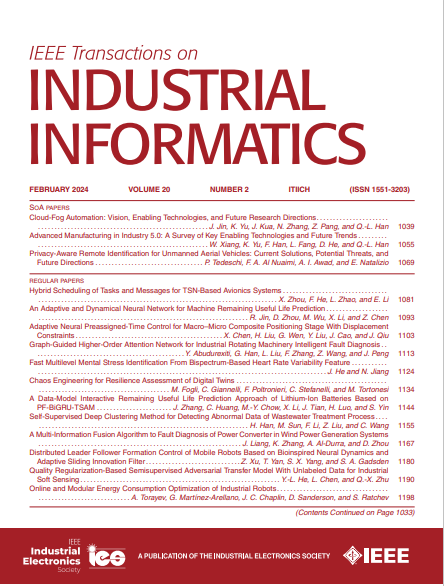基于振荡驻极体的极低频发射机以低功耗提高数据速率
IF 9.9
1区 计算机科学
Q1 AUTOMATION & CONTROL SYSTEMS
引用次数: 0
摘要
机械天线(MA)是实现工业信息化的极低频(ELF, 3-30 Hz)发射机的潜在解决方案。与传统发射机相比,它具有小型化和高效率的优点。然而,目前的ELF MA在符号切换中存在高惯性和长延迟的问题。这不仅会降低数据速率,而且还会在操作中造成不必要的功耗。本文提出了一种基于压电悬臂梁和振荡驻极体异质结构的紧凑ELF发射机,以及相应的信息传输程序。由复合压电材料制成的驱动器表现出快速的动态反应。将其与有效的频谱利用相结合,可以提高数据速率并降低功耗。在26.4 Hz频率下进行的概念验证演示获得了21 bit/s的数据速率,同时仅消耗1.52 W的功率。此外,增加驻极体的电荷密度可以在不需要额外功耗的情况下扩大传输距离,从而适应更具挑战性的应用,如水下物联网、穿越地球通信、管道检测和地下探测。本文章由计算机程序翻译,如有差异,请以英文原文为准。
Extremely-Low-Frequency Transmitter Based on Oscillating Electret Toward Increasing Data Rate With Low Power Consumption
The mechanical antenna (MA) is a potential solution for the extremely-low-frequency (ELF, 3–30 Hz) transmitter enabling industrial informatization. It can have the advantages of miniaturization and high efficiency compared to conventional transmitters. However, the current ELF MA has an issue with both high inertia and a long delay in symbol switching. Not only does this lower the data rate, but it also causes unnecessary power consumption in operation. This article proposes a compact ELF transmitter based on a heterogeneous architecture of piezoelectric cantilevers and oscillating electret, as well as a relevant information transfer program. The actuator fabricated from composite piezoelectric material exhibits a rapid dynamic reaction. Merging this with efficient spectrum utilization increases the data rate and reduces power consumption. A proof of concept demonstration conducted at a frequency of 26.4 Hz attained a data rate of 21 bit/s while consuming a mere 1.52 W of power. In addition, increasing the charge density of the electret can expand the transmission distance without requiring extra power consumption, thus adapting to more challenging applications such as Underwater Internet of Things, Through-the-Earth communication, pipeline inspection, and underground detection.
求助全文
通过发布文献求助,成功后即可免费获取论文全文。
去求助
来源期刊

IEEE Transactions on Industrial Informatics
工程技术-工程:工业
CiteScore
24.10
自引率
8.90%
发文量
1202
审稿时长
5.1 months
期刊介绍:
The IEEE Transactions on Industrial Informatics is a multidisciplinary journal dedicated to publishing technical papers that connect theory with practical applications of informatics in industrial settings. It focuses on the utilization of information in intelligent, distributed, and agile industrial automation and control systems. The scope includes topics such as knowledge-based and AI-enhanced automation, intelligent computer control systems, flexible and collaborative manufacturing, industrial informatics in software-defined vehicles and robotics, computer vision, industrial cyber-physical and industrial IoT systems, real-time and networked embedded systems, security in industrial processes, industrial communications, systems interoperability, and human-machine interaction.
 求助内容:
求助内容: 应助结果提醒方式:
应助结果提醒方式:


